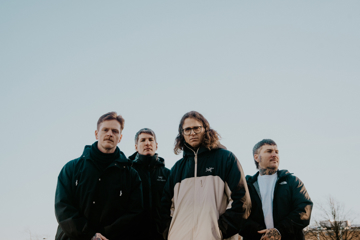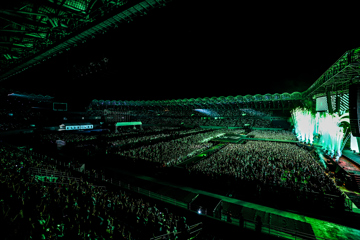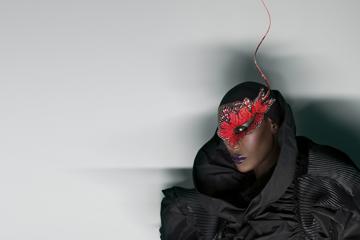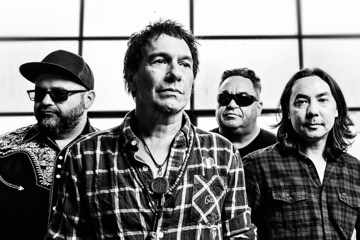Vale Bernard 'Doc' Neeson 1947-2014
The Music's Michael Smith pays tribute to the Australian rock legend

The Angels around the late '80s/early '90s - from left: Bob Spencer, Brent Eccles, Rick Brewster, Doc Neeson and James Morley.
“It suddenly became international in its own way,” Bernard “Doc” Neeson happily admitted in an episode ABC TV's Australian Story dedicated to his battle with a brain tumour that aired in April this year.
Neeson was referring to the crowd “response” that had somehow evolved over the years to the question in the title of the song that first put the band he fronted for three decades, The Angels, on the map. When he sang, “Am I ever gonna see your face again,” the crowds would respond with the phrase “No way, get fucked, fuck off”- which weren't ever lyrics in the song. “It now gets sung in pubs in England,” he continued. “I took a band to the Middle East, they were singing it there. In a way I'm really delighted to hear that because it's Australian audiences making a song their own. And from the point of view of when the band first started, we were trying to write songs for Australian audiences; they've made it their own in a way I'd never have thought possible.”
Described by his long-time friend, manager and drummer for many years in The Angels, Graham "Buzz" Bidstrup, as one of the most underrated singers in Australian rock history, Neeson lost his battle with a recurring cancerous brain tumour at 7.15am, Wednesday 4 June, passing away peacefully in his sleep. It would have been blessed relief for a man whose natural temperament would have normally seen him “rage against the dying of the light,” to quote another Celtic poet – for Neeson was also a poet, though it was as the near-demented “Doc” character he created as Angels frontman that the world will remember him.
Neeson, who was born in Northern Ireland's capital, Belfast, January 4, 1947, and arrived, aged 13, in Adelaide, South Australia, with his parents on 1960, had been something of an entrepreneur, setting up his own gigs and playing in a high school band called The Innocents. Yet his original career choice had been to become a primary school teacher. To that end, he was in his final year of study when he was conscripted. He was lucky; rather than being shipped off to Vietnam, his background prompted a posting in the education corp and service as a sergeant in Papua New Guinea, teaching the Pacific Island Regiment. On finishing his two years in the army, he took advantage of a Federal Government retraining scheme to enrol at Flinders University to study filmmaking, gaining an honours degree in Drama.
Don't miss a beat with our FREE daily newsletter
In 1971, at the suggestion of his flatmate John Woodruff, who was involved in their management, Neeson joined a band called the Moonshine Jug & String Band, which included the brothers John and Rick Brewster.
“The Jugband recorded a song that I wrote called Keep On The Move,” Neeson recalled, “and, really, it was a rock song. We recorded it as a jug band but we got a couple of players in and we had a bit of a hit with it. It went to number four in the charts in Adelaide. The jug band pulled lots and lots of people and it gave us a bit of a taste of success. We realised we could actually write a song, record it, put it out there and have a hit!
“We tried to do it again, and it was getting silly. Instruments started creeping in like a proper bass drum, and a bass guitar instead of a tub bass. I got an electric guitar and suddenly there was an amp on stage and we were getting more and more like a rock band, but still trying to be a jug band. [Producer] Peter Dawkins flew over from Sydney, came and saw the jugband play and offered us a deal – a dream come true! But we turned it down because we'd made the decision to form a rock band.
“So we went into that with the idea that, 'if we can do it with a jugband, in twelve months we'll be a big rock band!' And our first gig was opening for Cheech & Chong, who'd wanted the jug band! But we said no, we wanted to be The Keystone Angels, and we went over like a lead balloon. They hated us, and for very good reason – 'cause we were shithouse! But we persevered.”
With Neeson on bass, John and Rick Brewster on rhythm and lead guitar respectively, and Charlie King on drums, The Keystone Angels started to learn how to play rock'n'roll by playing the hits from the genre's birth, back in the 1950s, eventually managing to win over the audience at Sunbury in January 1975.
“I know Doc loved the '50s,” John Brewster explains, “and it's kind of a good grounding, so we started playing some of that stuff, and Rick and I would sing Everly Brothers songs. I'm glad we didn't get too cemented into that because we never would have gone anywhere with it, but it was a way to learn how to play.” As they learned to play rock'n'roll, the trio also learned to write together, the credits reading Brewster/Brewster/Neeson.
“They eventually had enough original material for us to come to Sydney,” manager John Woodruff remembers, “and I took them into EMI's studio to do Am I Ever Gonna See Your Face Again, went back to Adelaide to do a South Australian tour with AC/DC which I was promoting… The Angels took a long, long time to break and radio took a long time to start playing the band. The first single to do anything meaningful was Take A Long Line [August 1978]. It was a long uphill fight. Part of why it took so long was down to getting some idea of 'cool', which none of us had.”
That might seem surprising in hindsight, considering Am I Ever Gonna See Your Face Again was released in May 1976 and has become such an iconic song, yet it only reached #58 in the charts at the time. Even Take A Long Line only managed #29. It was live in concert where The Angels won their spurs, and it was the character that Neeson created out front that made the band. Touring their eponymous 1977 debut album, The Angels were still wearing their hair long, John Brewster was playing long harmonica solos and the songs betrayed a forgettable country-rock element. Something had to change.
“Probably where I drew on my drama more was in creating a 'Doc' persona,” Neeson explained, “and in that respect I drew a lot on stuff I'd studied in German Expressionism, and particularly German Expressionist cinema. One of the things about the Expressionists that I really got into was that they looked, in performing, on using a process of distorting the persona, the character, even the environment, to show the inner self, to define the inner soul, and I guess one of the things I got onto was we've all got a dark side which many of us try and stay away from, and so in a vicarious way I think I started touching that for people.”
Meanwhile, “The rock'n'roll was just not there,” Woodruff admits. “That came from George [Young] and Harry [Vanda] and Albert's, and those years when they were given free rein to go into the studio for as long as they liked, which turned out Face To Face, which was six to eight months in the making. George and Harry's input was to convince the band, like any good producer, that what they were doing was all to do with the band.”
When Face To Face was released in August 1978, the long hair was gone, as were the harmonica solos, Rick Brewster was sporting shades, standing stock-still peeling off short, sharp solos, and Neeson was careening around the stage, arms outstretched, eyes bulging, dressed sharp in waist coat and dress shirt. The album exploded, selling more than 280,000 copies and peaking at #16 in the album charts. Their next, 1979's No Exit, did even better, reaching #8, and in March 1980, Face To Face was released in America.
Over the next two decades, The Angels released a further ten studio albums, a live album and several 'best-ofs', including one #1 – 1990's Beyond Salvation – and two #2 albums – 1984's Two Minute Warning and 1987's Liveline – toured America as Angel City (there was a now-forgotten US band named The Angels), mounted record-breaking tours of Australia, sold hundreds of thousands of albums, became for a time the highest-paid band in the land and were inducted into the ARIA Hall of Fame in 1998.
The week before flying out to the East Timorese capital of Dili to entertain the troops in December 1999 at a special concert of Australian acts Neeson had initiated, his car was rammed from behind by a truck while he stopped to pay a freeway toll and he suffered severe whiplash and serious nerve damage to his neck and spine. He managed to get through the week in Dili pumped up with painkillers, but over the next three years, he experienced extensive periods of pain, illness, hospital stays and rehabilitation, the latter as a consequence of an addiction to painkillers. The experience effectively spelt the end of his association with The Angels.
Unfortunately, the decision by the Brewsters to resuscitate the band in 2003 without Neeson prompted a feud between them that remained unresolved at his death, even though they reunited briefly in 2007 for the second national Countdown Spectacular tour and the following year to celebrate the 30th anniversary re-release of Face To Face. Meanwhile, Neeson re-started his own career fronting, first, Doc Neeson's Angels, then Red Phoenix and finally, in rehearsal at the time he was felled by the brain tumour that ultimately killed him, The Angels 100%.
On Australia Day 2013, NSW Governor Marie Bashir presented Neeson with an Order Of Australia for his services to music and the community, and particular for establishing the Tour Of Duty – Concert For The Troops series of events. Three months later, he managed to perform Am I Ever Gonna See Your Face Again before 2,000 fans crammed into Sydney's Enmore Theatre at a fundraiser for him organised by his fellow musicians that included Jimmy Barnes, Peter Garrett and Angry Anderson. The last thing Bernard “Doc” Neeson recorded was an acoustic version of Vanda & Young's Walking In The Rain, which he'd performed on RocKwiz in November last year.
(Original quotes compiled from interviews undertaken by Michael Smith over the past dozen years)







